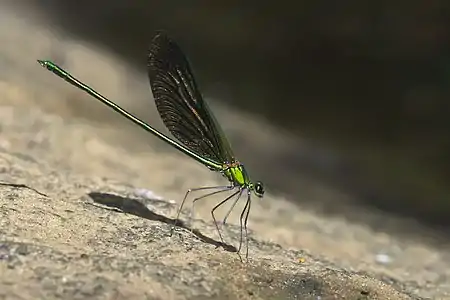Neurobasis chinensis
Neurobasis chinensis,[2] stream glory[3][4] is a species of damselfly in the family Calopterygidae. It is a common species distributed across much of Asia.[1][5]
| Neurobasis chinensis | |
|---|---|
 | |
| male | |
 | |
| female | |
| Scientific classification | |
| Domain: | Eukaryota |
| Kingdom: | Animalia |
| Phylum: | Arthropoda |
| Class: | Insecta |
| Order: | Odonata |
| Suborder: | Zygoptera |
| Family: | Calopterygidae |
| Genus: | Neurobasis |
| Species: | N. chinensis |
| Binomial name | |
| Neurobasis chinensis (Linnaeus, 1758) | |
| Synonyms | |
| |
Description and habitat
_male_2.jpg.webp)
It is a large metallic bronze-green colored damselfly. Its fore-wings are transparent, tinted in pale yellow with green neuration. Its hind-wings are opaque in brilliant metallic green or peacock-blue according to angle of view. They flash the wings, displaying the colors to attract females. The colour is produced by interference from the thin surfaces of the wing membrane.[6][7][4] Female is very similar to the male. But its wings are transparent and light coffee brown with white wings spots. There are another creamy yellow patches at the nodes.[8]
This species breeds in forest streams. The males maintain their territories along stretches of moderately fast-flowing streams. Normally found only near the water bodies. Female lays eggs in submerged vegetation, often among root masses.[9][8][10][3][4] The naiads burrow in sediment underwater and have a long abdomen that is held recurved above the body.[11]
References
- Dow, R.A. (2009). "Neurobasis chinensis". IUCN Red List of Threatened Species. 2009: e.T163763A5648117. doi:10.2305/IUCN.UK.2009-2.RLTS.T163763A5648117.en. Retrieved 20 November 2021.
- Paulson, D.; Schorr, M.; Abbott, J.; Bota-Sierra, C.; Deliry, C.; Dijkstra, K.-D.; Lozano, F. (2023). "World Odonata List". OdonataCentral, University of Alabama. Retrieved 14 Mar 2023.
- "Neurobasis chinensis Linnaeus, 1758". India Biodiversity Portal. Retrieved 2017-02-19.
- "Neurobasis chinensis Linnaeus, 1758". Odonata of India, v. 1.00. Indian Foundation for Butterflies. Retrieved 2017-02-18.
- K.A., Subramanian; K.G., Emiliyamma; R., Babu; C., Radhakrishnan; S.S., Talmale (2018). Atlas of Odonata (Insecta) of the Western Ghats, India. Zoological Survey of India. pp. 66–67. ISBN 9788181714954.
- Vukusic, P.; Wootton, R. J.; Sambles, J.R. (2004). "Remarkable iridescence in the hindwings of the damselfly Neurobasis chinensis chinensis (Linnaeus) (Zygoptera: Calopterygidae)". Proc. R. Soc. Lond. B. 271 (1539): 595–601. doi:10.1098/rspb.2003.2595. PMC 1691628. PMID 15156917.
- Kumar, A. & Prasad, M. (1977). "Reproductive behaviour in Neurobasis chinensis chinensis (Linnaeus) (Zygoptera: Calopterygidae)". Odonatologica. 6: 163–171.
- C FC Lt. Fraser (1934). The Fauna of British India, including Ceylon and Burma, Odonata Vol. II. Red Lion Court, Fleet Street, London: Taylor and Francis. pp. 121-124.
- Subramanian, K. A. (2005). Dragonflies and Damselflies of Peninsular India - A Field Guide.
- C FC Lt. Fraser (1924). A Survey of the Odonate (Dragonfly) Fauna of Western India and Descriptions of Thirty New Species (PDF). p. 479.
- Silsby, Jill (2001). Dragonflies of the World. CSIRO. p. 20.
External links
![]() Data related to Neurobasis chinensis at Wikispecies
Data related to Neurobasis chinensis at Wikispecies
![]() Media related to Neurobasis chinensis at Wikimedia Commons
Media related to Neurobasis chinensis at Wikimedia Commons
